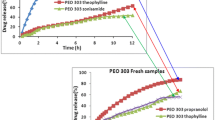Abstract
Stability of formulations over shelf-life is critical for having a quality product. Choice of excipients, manufacturing process, storage conditions, and packaging can either mitigate or enhance the degradation of the active pharmaceutical ingredient (API), affecting potency and/or stability. The purpose was to investigate the influence of processing and formulation factors on stability of levothyroxine (API). The API was stored at long-term (25°C/60%RH), accelerated (40°C/75%RH), and low-humidity (25°C/0%RH and 40°C/0%RH) conditions for 28 days. Effect of moisture loss was evaluated by drying it (room temperature, N2) and placed at 25°C/0%RH and 40°C/0%RH. The API was incubated with various excipients (based on package insert of marketed tablets) in either 1:1, 1:10, or 1:100 ratios with 5% moisture at 60°C. Commonly used ratios for excipients were used. The equilibrium sorption data was collected on the API and excipients. The API was stable in solid state for the study duration under all conditions for both forms (potency between 90% and 110%). Excipients effect on stability varied and crospovidone, povidone, and sodium laurel sulfate (SLS) caused significant API degradation where deiodination and deamination occurred. Moisture sorption values were different across excipients. Crospovidone and povidone were hygroscopic whereas SLS showed deliquescence at high RH. The transient formulation procedures where temperature might go up or humidity might go down would not have major impact on the API stability. Excipients influence stability and if possible, those three should either be avoided or used in minimum quantity which could provide more stable tablet formulations with minimum potency loss throughout its shelf-life.







Similar content being viewed by others
References
Goodman L, Gilman A. The pharmacological basis of therapeutics. 10th ed. New York: McGraw-Hill; 2001.
Rhodes C. Regulatory aspects of the formulation and evaluation of levothyroxine tablets. Clin Res Regul Aff. 1998;15:173–86.
FDA. Regulatory history and current issues. Health & Human Services; 2006.
Post A, Warren R. Sodium levothyroxine. In: Florey K, editor. Analytical profiles of drug substances. New York: Academic Press; 1976. p. 226–81.
Won CM. Kinetics of degradation of levothyroxine in aqueous solution and in solid state. Pharm Res. 1992;9:131–7.
Kazemifard AG, Moore DE, Aghazadeh A. Identification and quantitation of sodium-thyroxine and its degradation products by LC using electrochemical and MS detection. J Pharm Biomed Anal. 2001;25:697–711.
Wortsman J, Papadimitriou DC, Borges M, Defesche CL. Thermal inactivation of l-thyroxin. Clin Chem. 1989;35:90–2.
Patel H, Stalcup A, Dansereau R, Sakr A. The effect of excipients on the stability of levothyroxine sodium pentahydrate tablets. Int J Pharm. 2003;264:35–43.
Das Gupta V, Odom C, Bethea C, Plattenburg J. Effect of excipients on the stability of levothyroxine sodium tablets. J Clin Pharm Ther. 1990;15:331–6.
Burger A, Griesser UJ. Physical stability, hygroscopicity and solubility of succinyl-sulfathiazole. Eur J Pharm Biopharm. 1991;37:18–24.
Morris KR, Griesser UJ, Eckhardt CJ, Stowell JG. Theoretical approaches to physical transformations of active pharmaceutical ingredients during manufacturing processes. Adv Drug Deliv Rev. 2001;48:91–114.
Otsuka M, Hasegawa H, Matsuda Y. Effect of polymorphic transformation during the extrusion-granulation process on the pharmaceutical properties of carbamazepine granules. Chem Pharm Bull. 1997;45:894–8.
Phadnis NV, Suryanarayanan R. Polymorphism in anhydrous theophylline—implications on the dissolution rate of theophylline tablets. J Pharm Sci. 1997;86:1256–63.
Monkhouse DC. Stability aspects of preformulation and formulation of solid pharmaceuticals. Drug Dev Ind Pharm. 1984;10:1373–412.
Kandarapu R, Grover V, Chawla HPS, Garg S. Evaluation of the compatibility of ketorolac tromethamine with selected polymers and common tablet excipients by thermal and isothermal stress testing. S T P Pharma Sci. 2001;11:449–57.
Serajuddin AT, Thakur AB, Ghoshal RN, Fakes MG, Ranadive SA, Morris KR et al. Selection of solid dosage form composition through drug-excipient compatibility testing. J Pharm Sci. 1999;88:696–704.
Gu L, Strickley RG, Chi LH, Chowhan ZT. Drug-excipient incompatibility studies of the dipeptide angiotensin-converting enzyme inhibitor, moexipril hydrochloride: dry powder vs wet granulation. Pharm Res. 1990;7:379–83.
Shah RB, Bryant A, Collier J, Habib MJ, Khan MA. Stability indicating validated HPLC method for quantification of levothyroxine with eight degradation peaks in the presence of excipients. Int J Pharm. 2008;360:77–82.
Kopelman SH, Augsburger LL. Excipient compatibility study of Hypericum perforatum extract (St. John’s Wort) using similarity metrics to track phytochemical profile changes. Int J Pharm. 2002;237:35–46.
Patel N, Patel I, Cutie A, Wadke D, Monkhouse D, Reier G. The effect of selected direct compression excipients on the stability of aspirin as a model hydrolysable drug. Drug Dev Ind Pharm. 1998;14:77–98.
van Dooren AA, Duphar BV. Design for drug–excipient interaction studies. Drug Dev Ind Pharm. 1983;9:43–55.
Kowalski J, Kalb O, Joshi YM, Serajuddin ATM. Application of melt granulation technology to enhance stability of a moisture sensitive immediate-release drug product. Int J Pharm. 2009;381:56–61.
Andre A, Domanig R, Riemer E, Moser H, Groeppelin A. Identification and thermal degradation products of l-triiodothyroxine sodium (liothyroxine sodium) by reversed phase HPLC with photodiode-array UV and mass spectrometric detection. J Chromatogr A. 1996;725:287–94.
Disclaimer
The opinions expressed in this work are only of the authors, and do not necessarily reflect the policy and statements of the FDA.
Author information
Authors and Affiliations
Corresponding author
Rights and permissions
About this article
Cite this article
Collier, J.W., Shah, R.B., Gupta, A. et al. Influence of Formulation and Processing Factors on Stability of Levothyroxine Sodium Pentahydrate. AAPS PharmSciTech 11, 818–825 (2010). https://doi.org/10.1208/s12249-010-9434-8
Received:
Accepted:
Published:
Issue Date:
DOI: https://doi.org/10.1208/s12249-010-9434-8




